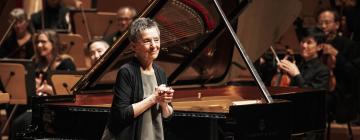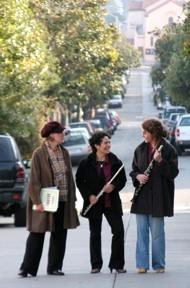
Photo by Amy Fowler
The peak of Bernal Heights Park provides a broad and beautiful perspective on San Francisco, the city which will be celebrated in a concert by the Bernal Hill Players at the Community Music Center (CMC) on June 18. SFCV stopped by the connubial home of pianist Jennifer Peringer and flautist and vocalist Martha Rodriguez-Salazar, a couple of blocks south of the Park, to chat about the Players, their program, and the CMC, where they both teach.
How did the Players get formed, and are you all really from this neighborhood?
Jennifer Peringer:
We started playing in 2008, Martha and I and a friend of ours, Leah diTullio. She plays clarinet and she lives just on the other side of Cesar Chavez [Street], so she walks over the hill to meet up with us, once a week, to play. When we started out (there was a violist with us), we played Brahms and Schumann and Saint-Saëns, the classical music that we loved. Then we started to run out of repertoire pretty quick, because there hasn’t been that much written for clarinet, flute, and piano. I started arranging stuff that suited me, I’m really interested in world music, and even when I play classical, I love stuff with strong local flavors, like Khachaturian.
Martha Roriguez-Salazar: I was trained at the National School of Music in Mexico City, and that was mostly classical, but then I joined forces with a guitar player and we played all around the city, not only classical but also boleros and Latin American folk music. When I came here in ‘98, I started to work with the Coro Hispano de San Francisco, and that’s where I came together with all this amazing Latin American classical and folk music.
JP: We began playing quite a bit of Spanish repertoire, and I arranged some Piazzolla and some Falla. And from there, we started getting grants, and commissioning people to write for us. And we immediately came up with this theme, of getting pieces about San Francisco.
MR-S: A friend of mine, Loren Jones, who’s part of the San Francisco Composers Chamber Orchestra, came to our concerts and loved it, and decided to give us The Bernal Hill Suite.
That’s on your upcoming program. How does it evoke the neighborhood?
MR-S: Loren Jones said he wanted to transmit the energy of liberal openness, not only culturally and intellectually, but also on gay issues. So some of the music is very energetic and happy, and some has to do with being more peaceful.
JP: [On Cortland Avenue, Bernal’s main drag] We have Progressive Grounds (a great name for a café) and the Wild Side West [bar], a most historical place in terms of gay culture. And an art gallery a couple of blocks away, where we perform sometimes. And we have another piece by Beth Custer [from her Bernal Heights Suite], where the lyrics are a list of trees and plants she sees when she goes for walks, growing on Bernal Hill.
MR-S: I’m going to be singing them: bayberry, beech, pine, cala lily, dandelion — and poison oak. Musically, it’s kind of a suspended motion piece, like the Heights: we’re up there.
Where else in San Francisco will we be hearing?
JP: There’s a piece by Erik Pearson, who’s another faculty member at the CMC, and studied at Berkeley. [With the Birds Above Fort Funston] is based on seeing hang gliders at the beach there. It seems informed by Minimalism. I’m doing this repetitive thing in the piano, I guess I’m the ocean ‘cause I get to play these low clusters, waves and they [Rodriguez-Salazar and diTullio] get to be the birds.
MR-S: Then there’s another piece by another friend of ours, another teacher at the CMC, Chus Alonso, he’s a flute player, a salsa player, and he’s composed Suite de Los Barrios. The three movements move from Ocean Beach to the Financial District and finish in the Mission, where you hear some kind of carnaval.
JP: Kartina Wreede wrote a piece, Episodes in China Basin. She also works at the CMC , and is a violist and composer. She was really attracted to the combination of industry and nature at China Basin. She has sort of a jazzy edge which attracted me, and I talked her into letting me play cowbell on my knee, while I’m playing the piano. The pieces by Katrina and by Peter Josheff will be world premieres. I’d met Peter when I was accompanying, out at San Francisco State, and he was teaching clarinet. He plays with Earplay and is immersed in the contemporary scene, and in his piece [Sutro Tower In the Fog], there’s changes of meter all the time.
MR-S: It’s a very different piece from the rest, a different mood and atmosphere. Many times the flute does only a kind of resonance, a lot of long notes. He decided that instead of being very abstract, he wanted to portray what it feels to be in front of Sutro Tower.
JP: He said, it’s this huge presence, and yet it doesn’t have a soul. He finds it spooky.
It sounds like several of you, players and composers alike, have a CMC connection. What is it about that place?
MR-S: I’ve been there for 10 or 11 years, and I’ve always felt, any time I would propose something, like our Latin vocal workshop or our program with Latina seniors, they’ve always been very open to receive that influence. Being in the Mission [on Capp Street], they’re aware they’re in the middle of a lot of cultures, and in the Richmond [CMC’s other location] as well, which is very Asian. They’re aware that if you don’t embrace it, you become very exclusive. And they have a mission of providing music to the community, regardless of financial status.
JP: One of the few places that still does sliding scale —
MR-S: — and that brings a lot of wonderful concerts, for free [including this one].
JP: They’re really supportive of their faculty, too. You get access to their concert hall, and they have grants you can apply for, for your own professional development. We got funding for our concerts, and for a recording of the program. We were funded for the compositions, by Subito (the American Composers Forum) and from the San Francisco Friends of Chamber Music.
Is this concert a milestone for the Bernal Hill Players?
MR-S: We’ll be doing some projections, which we’ve never done, of images of San Francisco, and drawings by some of the composers.
JP: It’s actually a continuation of a project called San Francisco: In and About the City. We want to commission more pieces about the city, and get some other cultural elements. We’d like to get a composer of Asian heritage, to compose something about Chinatown or Japantown, and we’d love to get an African-American element, too.
MR-S: I’d like to go to Mexico and commission pieces from the neighborhoods of Mexico City, and bring that back here. So it would eventually be a cultural exchange.
You’re working on a global community.

